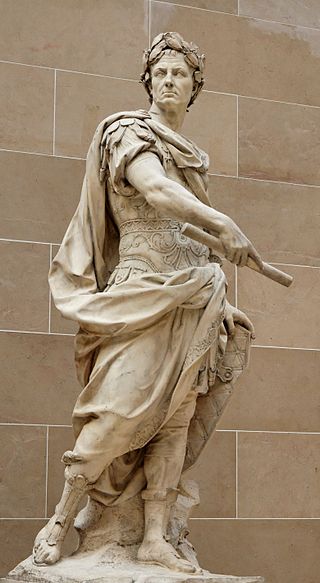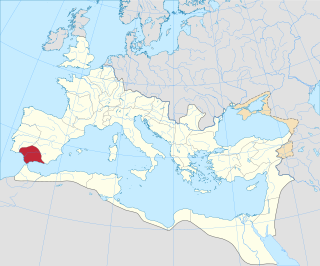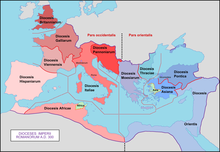
Lusitania was an ancient Iberian Roman province encompassing most of modern-day Portugal and a large portion of western Spain. Romans named the region after the Lusitanians, an Indo-European tribe inhabiting the lands.

The following outline is provided as an overview of and topical guide to ancient Rome:

The Roman provinces were the administrative regions of Ancient Rome outside Roman Italy that were controlled by the Romans under the Roman Republic and later the Roman Empire. Each province was ruled by a Roman appointed as governor.

Hispania Tarraconensis was one of three Roman provinces in Hispania. It encompassed much of the northern, eastern and central territories of modern Spain along with modern northern Portugal. Southern Spain, the region now called Andalusia, was the province of Hispania Baetica. On the Atlantic west lay the province of Lusitania, partially coincident with modern-day Portugal.

Gallia Narbonensis was a Roman province located in what is now Occitania and Provence, in Southern France. It was also known as Provincia Nostra, because it was the first Roman province north of the Alps, and as Gallia Transalpina, distinguishing it from Cisalpine Gaul in Northern Italy. It became a Roman province in the late 2nd century BC. Gallia Narbonensis was bordered by the Pyrenees Mountains on the west, the Cévennes to the north, the Alps on the east, and the Gulf of Lion on the south; the province included the majority of the Rhone catchment. The western region of Gallia Narbonensis was known as Septimania. The province was a valuable part of the Roman Empire, owing to the Greek colony and later Roman Civitas of Massalia, its location between the Spanish provinces and Rome, and its financial output.

Hispania Baetica, often abbreviated Baetica, was one of three Roman provinces created in Hispania on 27 BC. Baetica was bordered to the west by Lusitania, and to the northeast by Tarraconensis. Baetica remained one of the basic divisions of Hispania under the Visigoths. Its territory approximately corresponds to modern Andalusia.

Gallaecia, also known as Hispania Gallaecia, was the name of a Roman province in the north-west of Hispania, approximately present-day Galicia, northern Portugal, Asturias and Leon and the later Kingdom of Gallaecia. The Roman cities included the port Cale (Porto), the governing centers Bracara Augusta (Braga), Lucus Augusti (Lugo) and Asturica Augusta (Astorga) and their administrative areas Conventus bracarensis, Conventus lucensis and Conventus asturicensis.

The Dominate, also known as the late Roman Empire, is the despotic form of imperial government of the late Roman Empire. It followed the earlier period known as the Principate. Until the empire was reunited in 313, this phase is more often called the Tetrarchy.

Tarraco is the ancient name of the current city of Tarragona. It was the oldest Roman settlement on the Iberian Peninsula. It became the capital of Hispania Tarraconensis following the latter's creation during the Roman Empire.

Mauretania Caesariensis was a Roman province located in what is now Algeria. The full name refers to its capital Caesarea Mauretaniae.

Hispania Citerior was a Roman province in Hispania during the Roman Republic. It was on the eastern coast of Iberia down to the town of Cartago Nova, today's Cartagena in the autonomous community of Murcia, Spain. It roughly covered today's Spanish autonomous communities of Catalonia and Valencia. Further south was the Roman province of Hispania Ulterior, named as such because it was further away from Rome.

Hispania Balearica was a Roman province encompassing the Balearic Islands off the east coast of modern Spain. Formerly a part of Hispania Tarraconensis, Balearica gained its autonomy due to its geographic separation and economic independence from the mainland. The province included three major islands: Balearis Major (Majorca), Balearis Minor (Minorca), and Ebusus (Ibiza), and the small island of Colubraria or Ophiusa (Formentera). The islands were grouped as the Gymnesiae—Majorca and Minorca, and the Pityusae—Ibiza and Formentera.
Municipium Cives Romanorum Felicitas Julia Olisipo was the ancient name of modern-day Lisbon while it was part of the Roman Empire.

The Diocese of Dacia was a diocese of the later Roman Empire, in the area of modern western Bulgaria, central Serbia, Montenegro, Kosovo, northern Albania and northern North Macedonia. It was subordinate to the Praetorian prefecture of Illyricum. Its capital was at Serdica.

In the Late Roman Empire, usually dated 284 AD to 641 AD, the regional governance district known as the Roman or civil diocese was made up of a grouping of provinces each headed by a Vicarius, who were the representatives of praetorian prefects. There were initially twelve dioceses, rising to fourteen by the end of the 4th century.

The Diocese of the Seven Provinces, originally called the Diocese of Vienne after the city of Vienna, was a diocese of the later Roman Empire, under the praetorian prefecture of Gaul. It encompassed southern and western Gaul, that is, modern France south and west of the Loire, including Provence.

Hispania was the Roman name for the Iberian Peninsula. Under the Roman Republic, Hispania was divided into two provinces: Hispania Citerior and Hispania Ulterior. During the Principate, Hispania Ulterior was divided into two new provinces, Baetica and Lusitania, while Hispania Citerior was renamed Hispania Tarraconensis. Subsequently, the western part of Tarraconensis was split off, initially as Hispania Nova, which was later renamed "Callaecia". From Diocletian's Tetrarchy onwards, the south of the remainder of Tarraconensis was again split off as Carthaginensis, and all of the mainland Hispanic provinces, along with the Balearic Islands and the North African province of Mauretania Tingitana, were later grouped into a civil diocese headed by a vicarius. The name Hispania was also used in the period of Visigothic rule.

Hispania Carthaginiensis or Carthaginensis was a province of the Roman Empire with its capital at Carthago Nova. It covered the central Mediterranean coast of Spain around the city and its hinterland into central Iberia.

A legatus Augusti pro praetore was the official title of the governor or general of some Imperial provinces of the Roman Empire during the Principate era, normally the larger ones or those where legions were based. Provinces were denoted imperial if their governor was selected by the emperor, in contrast to senatorial provinces, whose governors were elected by the Roman Senate.



















